How high do fences need to be for chickens?
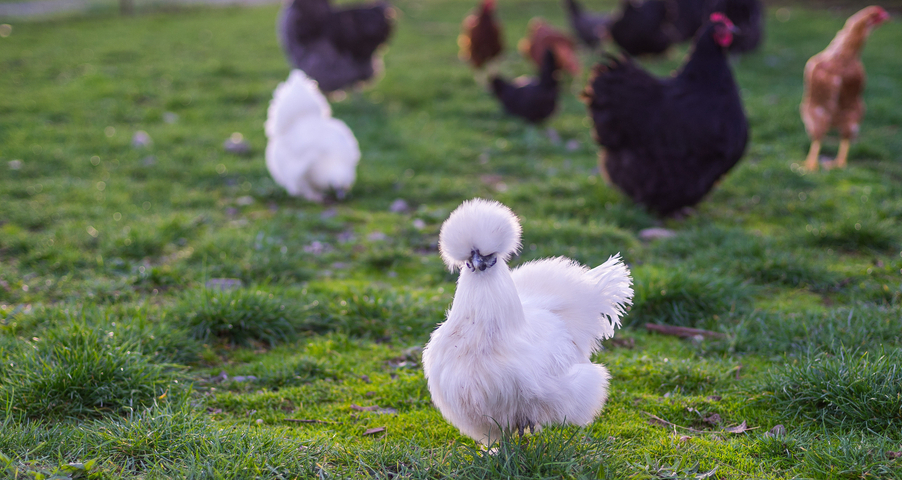
Poultry fences need to be at least 6 foot tall to keep chickens in and to keep predators out. Fences also need to be buried into the ground at least 6 inches to stop chickens getting underneath them. You should choose heavy duty fence with small holes.
Foxes can easily jump anything less than 6 foot and chickens can easily get over low fences.
Do I need to fence in my chickens?
You are responsible for your livestock and any damage they do and a decent fence is one way to make sure they stay inside the run. It also helps protect them from predators which would otherwise be making a meal of your flock.
Below: This is one of my chickens heading over a 5 foot fence with no trouble at all.

Chickens roam quite far if allowed to free range and a good fence marks a boundary. They generally stay inside for the most part. Chickens will happily stay home if they have everything they need underfoot in the run.
The one thing I have noticed with chickens and fences is that if there is a clearly defined top to the fence they are much more likely to try and fly up to it.
If you watch chickens that escape they generally do it by flying to the top of a fence post and then over.
Chickens like to be able to see the point they are flying up to.
I did have an escape artist hen that used to flap climb up the fence and whilst it was hilarious to watch it made getting hatching eggs a bit of a challenge as she kept getting in with other roosters.
How high do fences need to be for chickens?
I have a mix of breeds and sizes from the tiny little Serama bantam to the large fluffy Orpington and I have all my fences at least 6 foot tall to keep chickens in. This height works for most birds and breeds although some will still escape.
Below: Fences for chickens need to be 6 foot tall.
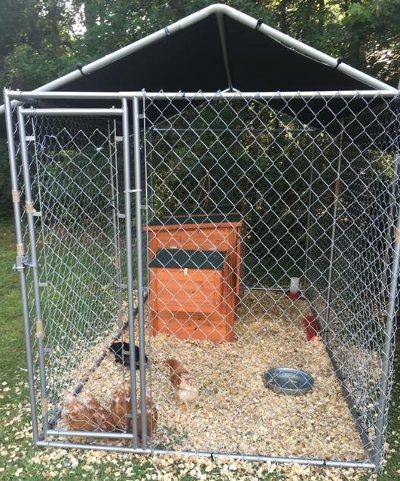
Sebrights and Hamburgs fly incredibly well. Cochins, Pekins and Silkies not at all so it really varies. My bantam Cochin frizzle can't fly but she is a really good digger and kept getting under the fence by digging small holes and squeezing through.
Leghorns fly very well and I've seen mine clear a 5 ft fence with a clipped wing.
Consider building a chicken tractor or wheeled coop and run combo. If you are hoping to free range them but live in the city where flying over the fence just isn't an option.
Do bantam need a tall fences?
Depends what kind of bantam. My Cochins hardly fly at all, and same with the Brahmas. Most bantams can fly really well. The best thing with bantams is to cover the run if you can.
My Japanese Bantams will fly up onto my house roof if they are startled. From my experience most chickens prefer to be on the ground and only fly when they have to.
They can fly in long straight lines, and gain height, like a regular bird! She really goes more for distance and is fairly low to the ground, but if she's startled she can get a good 6+ feet of height. The roosters don't fly as much, but the younger ones will fly like crazy when they want to. They do settle down as they start to lay eggs.
You could clip their wings and then the fence will keep them in. I don't do this any more as one day some hopped up a tree and went over the fence, then could not get back in - and 2 got killed by a dog.
With a full set of feathers they can fly away from danger!
I would just build a tractor. They're pretty easy and don't have to be very big for bantams, and you get the grass, bugs, foraging experience without the risk of one hopping the fence.
A fence to keep chickens in has to be 6 foot or 1.8 metres high. I recommend the same to keep bantams inside the yard so they can free range.
Can chickens fly over a 4 foot fence?
Chickens can easily get over a four foot fence with the possible exception of the Silkie and my Orpingtons. Most heavy breeds prefer to stay put but are quite capable of getting over a 4 foot fence.
Below: Yes chickens can easily get over a 4 or 5 foot fence if they want to.
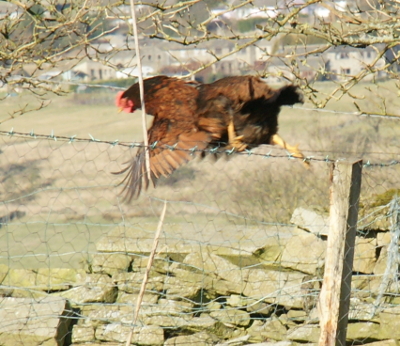
Standard 4 foot stock fence is not really any good for keeping chickens in a run.
What kind of fence do I need for chickens?
Poultry and chickens fences come in a few different types, Either plastic or metal chicken wire or poultry netting, hardware cloth, chain link fence or weld mesh. They all have their advantages and disadvantages.
Chicken wire:
Chicken wire, also called poultry netting, is mainly used for fencing poultry. It is made from galvanised wire. Flexibility and durability are the two prominent features.
Below: Standard poultry chicken wire.

The hexagonal gaps in chicken wire can range from 1/2 inch to 2 inches. The 1/2-inch type of chicken wire should be selected if you are trying to keep out small rodents like field mice.
Chicken wire can also be used for encircling individual shrubs or trees to keep the chickens away from them.
It does not have the strength to keep out determined predators like foxes.
Hot-dipped galvanised chicken wire offers excellent corrosion resistance property and oxidation resistance. Moreover, it has a long service life. Electro galvanised chicken wire is usually made of high-quality low carbon steel wire, or galvanised wire.
Stainless steel chicken wire is mainly made of thin and flexible galvanised wire with hexagonal gaps. This type of chicken wire has superior strength and corrosion resistance and an eye watering price tag to match.
The standard roll length of chicken wire is 50 m. Different diameters are available, including 1 inch (about 2.5 cm) diameter, 2 inch (about 5 cm) and 1/2 inch (about 1.3 cm). There are various wire gauges to choose, ranging from 19 gauge (1 mm wire) to 22 gauge (0.7 mm).
Chain link fence:
Chain link fencing consist of twisted interlocking lengths of strong wire and is either galvanised coating or PVC coated to make sure of a long life. Flexible woven diamond pattern provides durable construction.
It is widely used fencing for raising chicken, ducks, geese and rabbits and zoo fencing.
The big advantage of chain link fencing is the long life and security. The closely spaced diamond mesh construction gives your fence linear strength and springy texture to prevent predators from entering.
It is however much more expensive and requires tools and skills to install.
Hardware cloth:
Hardware cloth is a sturdy mesh product sold in rolls at your local hardware store or tractor supply. Made from metal or plastic, hardware cloth cuts and fixes easily and can be used for all kinds of pet projects around the house and garden.
Below: The types of chicken fence. From left to right: Hardware cloth, weld mesh and plastic moulded mesh.
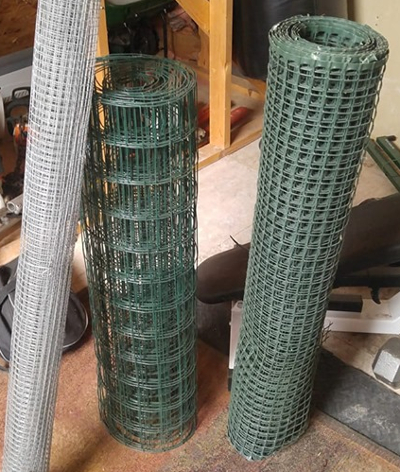
Weld mesh:
Weld mesh is sturdy sheets of welded wire with very little or no flex in them at all. They are very expensive and strong and normally require welding to metal fence posts. It is not often used for chicken keeping unless you need to keep bears or similar animals out.
Plastic Chicken Wire:
Plastic chicken wire is mainly made of polyethylene and polypropylene. It has excellent corrosion resistance, toughness and flexibility. What's more, a variety of colours are available, including black, white, blue, green, yellow and so on.
Plastic poultry netting specifications:
Mesh size : 0.5-60 mm and Wire diameter: 0.12-5.0 mm
Below: This plastic chicken fence may keep the hens in but it won't keep the predators out.

With plastic chicken fence you should go for a very heavy duty mesh.
Can you use electric fences for chickens?
Yes, electric fences can be used to keep chickens in or out of an area. They have to be the mesh type and not the single or double wire systems normally found for livestock.
Below: Chickens behind and electric fence.
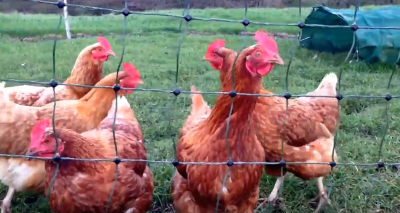
How do electric fences for chickens work?
Electric fences for keeping hens in a run are made from a plastic mesh with thin metal wires that carry the current. An Energiser delivers between 5000 and 8000 volts around once a second as a pulse through the wires.
Both chickens and predators learn very quickly that it is an unpleasant experience and avoid the fence in future.
Electric fences deliver a high voltage but very low current. It need to be a high voltage so as it can get through the chickens feathers or the animals fur. Both fur and feathers are good insulators so a sizeable electric shock is needed.
In humans touching the wire results in an unpleasant feeling caused by an electric shock is basically a muscle spasm. And it makes you jump.
Will an electric fence kill a chicken?
No. Electric fences are completely safe with the majority of farm animals and poultry is no exception. Most chickens only require a single shock and then go on to avoid the wires.
If your animal has a heart defect the shock may cause a heart attack but I have only ever heard about this and never seen it.
Will electric fence keep foxes away?
As a rule yes, Foxes and badgers are likely to be deterred by electric fences. There is never a guarantee though and a fox may be able to jump over electric fences if they are not high enough.
Below: Electric poultry fence is a woven mesh that has small wires woven in.
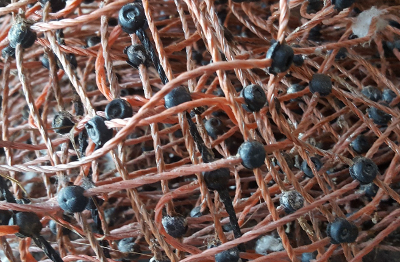
Foxes can easily get over a 5 foot or 1.2 metre high fence and although electric fences are more difficult for them to get over it still needs to be 1 metre or 3 foot 6 tall.
The fox prefers a solid fence that is easy to climb. A soft wobbly one like a chicken electric fence is a double deterrent.
What is the best fence for chickens?
The best chicken fence really depends on you conditions.
If money is no object then go for 8 high foot chain link fence, it will last a lifetime and deter most predators and can be purchases in ready to use sections or ready made enclosures.
Below: This chain-link is the best solution for chicken fence. Sturdy, tall and easy to put up but costly.
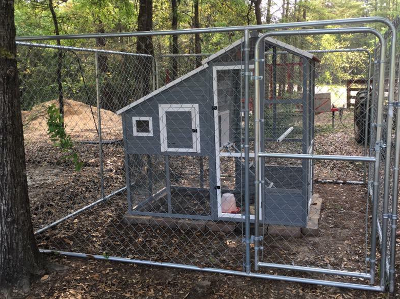
Otherwise go for the tallest chicken mesh and the strongest fence posts you can easily get and install.
How to fence chickens?
Chicken wire fence is absolutely an ideal product for fencing poultry like rabbits and chickens. Poultry netting is available in plastic, stainless steel wire, galvanised wire or high-quality low carbon steel wire.
The reason why chicken wire fence is so popular now is perhaps due to its cost-effectiveness and easy installation. It requires no special skills to install a chicken wire fence on your own.
Remember to always measure twice and cut once. You just need to follow the directions below:
- Prepare enough fence and determine the number of stakes you need. Wooden stakes or fence posts are the cheapest and easiest to get hold of.
- Measure the distance and divide it up so the stakes are around 5 foot apart. If you live in rough conditions then add an extra stake or two to bring them closer together and make the fence more sturdy.
- Hammer or drive the fence posts into the ground. Make sure you leave a few inches spare so as you are not short of fence post length when it comes to hanging the wire.
- Use two lengths of fencing wire, one at ground level and the other at the top of the mesh. So 6 foot apart if you are putting up 6 foot mesh. Start at the gate and work to one corner at a time pulling it taut and fixing it to every post with fencing pins. Finish up back at the other side of the gate.
- Unroll the poultry mesh and start hanging from the top wire as you go. I use little tie wraps, zip ties or cable ties to hang every few feet as i go. This means it hangs nice and even ready for the next step.
- Attach the fencing to the first (Gate Post) and pull taut. I do 1 side at a time and pull the whole side taut. Use fencing pins to staple the fence to the posts.
- Use galvanised wire to fix the fence panels to the top and bottom wire. Give a twist every few feet so that even if one section breaks it doesn't unravel the whole top or bottom.
